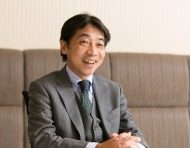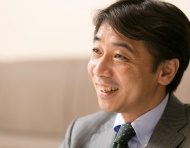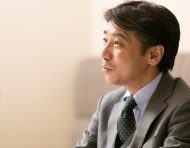Hajime Kambayashi

- Classification
- Evolving Investment Opportunities
- Company
- S.O.W. Asset Management Inc. (currently Kanden Asset Management)
Joined Tokyu Land Corporation in 1990. Engaged in development of residence, securitization and set-up of REIT business.
Joined Mitsubishi Securities in 2003. Worked in arrangement of private real estate funds and REIT underwriting.
Joined S.O.W. in 2005. Became CEO of S.O.W. Asset Management in August, 2013.

While we manage funds investing in real estate, they are different from typical real estate funds. Typical real estate funds usually invest in office buildings and residential properties and then lease them to multiple tenants. Those funds also sometimes aim to achieve capital gains as a result of increase in the price of their properties in addition to the income gains from rent payments. On the other hand, the investment strategy of SOW Asset Management’s funds is to get steady income gain through providing financing to business operators in the form of real estate investments. SOW Asset Management’s philosophy behind this strategy is to help various business operators grow their businesses through providing financing service.
Generally speaking, there are two options as financing means available to business operators, namely debt financing and equity financing that both involve the right side of the balance sheet. Our “Asset finance strategy” involves the left side of the balance sheet.
There are certain types of properties that are essential for companies to operate their businesses, e.g,. shops and stores for retailers. However, those business operators can run their operations by renting such properties instead of owning them. To do so, a business operator can use the method called ‘sale-and-lease-back transaction’ where the business operator sells and leases back its ‘real estate’ on the left side of the balance sheet in order to obtain financing in the form of proceeds from the property sales. The business operator can then use the money that it has obtained to either make investments for further business growth or to reduce the amount of interest-bearing debt in order to improve its financial standing. In both cases, Our fund’s investment meets the business operator’s financing needs.
We believe ‘sourcing’ is the crucial part of any investment process. Generally, real estate funds obtain information on available properties through brokers and choose potential investment targets from them most of the time. Needless to say, as each property is unique and exists by itself, there can be only one buyer per one property. As good properties attract a number of potential buyers, they often become subject to bidding, which tends to drive up the prices of those properties. Such method of acquiring properties in the open real estate market is referred to as ‘on-market acquisition.’
On the other hand, Our basic method of real estate acquisition is called ‘off-market acquisition,’ i.e., acquisition of properties through direct communication with business operators. In some cases, we find opportunities to propose asset financing ideas to business operators for whom we initially provided financial consulting services. In other cases, we come across off-market acquisition opportunities through the introduction of lawyers. We have recently witnessed an increase in the number of deals made through the introduction of megabanks.
By utilizing such sourcing channels, SOW Asset Management tries to understand the unique financing needs of each business operators and makes optimal proposals accordingly.
Because we cannot always meet the sale-and-lease-back needs of each business operator right from the start, we initially try to meet the business operator’s needs by providing information on properties where it might want to set up a shop or store, or by advising how the business operator could expand its sales channels. Through this phase of communication, we might be able to obtain additional information from the business operator, such as a case where the business operator is renting a property but feels a sense of distrust toward the owner of the property, or a case where the property owner is not responsive to the business operator’s request to repair the property being rented. In such cases, our fund may decide to take over the property from the current owner, in which case it will be an owner-changing transaction instead of a sale-and-lease-back transaction. Such process requires tremendous amounts of cost and time. However, since the distingushing feature of our funds depends on it, we are fully dedicated to engaging ourselves in the process in our everyday operation without taking any shortcuts.

I understand that many people view real estate as a high-risk investment target. Indeed, I often hear people say that they are afraid of investing in real estate, because of the risk of capital loss in spite of the potential for capital gain. However, I believe real estate is a type of asset that is very suitable for realizing income gains continuously. There are a variety of methods that can be used to invest in real estate in order to achieve steadier income flows, “or rent revenue”. In the application of asset financing strategy, if the real estate is important and essential for the company that is using it, it is assumed that the company will most likely continue to use the real estate and pay the rent. In order to ensure that the rent income will indeed be generated steadily for the long term, we include various provisions in a lease contract. SOW Asset Management has special know-how on how to stipulate such provisions in order to realize/embody our asset financing strategy.
What’s also important along with the steadiness of the income flows is low volatility of the price of the investment unit. When listed JREITs a representative securitized real estate product first entered the marketplace, investors expected them to have medium-risk and medium-return characteristics somewhere between those of stocks and bonds. However, it has turned out that JREITs unit prices are as highly volatile as stock prices and also have high correlation with stock prices. In our Asset financing fund, we put emphasis on realizing income instead of capital gains in order to reduce volatility. This is one of the features of our strategy that is highly valued by our clients(investors).

I used to work for a securities company where I was responsible for making various arrangements to securitize real estate. While the securitization work mainly involved sales-and-lease-back of properties, there was a shortage of investors that were willing to take risk money. Therefore, the orignators usually took a stake in the equity portion of the deals themselves, while the debt portion was financed through non-recourse loans and CMBSs in most cases. Because there were still residual risks to the originators, it was sometimes ridiculed as ‘pseudo-securitization.’ As time passed and the accounting policies on off-balance-sheet arrangements got stricter, it became more difficult to employ methods that would have originators undertake residual risks, and so companies stopped securitizing their real estate through sales-and-lease-back transactions. However, there is still a high demand among business operators to securitize real estate. Their objectives for securitizing real estate vary from the need to make their balance sheets more compact to the diversification of financing options and accelerated expansion of store and business locations and so on. So there are needs for this type of fund that is capable of meeting such financing needs.
The type of money that is optimal for meeting such sales-and-lease-back needs of business operators is financing that is oriented to receiving steady income gains not capital gains. We find joy in being able to match our investors’ needs directly with the needs of companies that require financing to operate their businesses in a creative manner, so that the investors and business operators can build win-win relationships and also achieve mutual growth.

This goes without saying, but my utmost priority is loyalty to our clients(investors).
While our clients(investors) expect us to be adept at finding good investment deals, structuring those deals through unique methods, making optimal financing arrangements, and properly managing investments during the contractual periods and so on, they particularly count on us being able to provide professional expertise on the screening of available deals so that the right investment decisions can be made. In this regard, we must always live up to our clients’(investors’) expectations.
There was this investment deal that I previously worked on, which was ready to be executed once we made the decision to go forward. However, we discovered that there were certain conditions during the due diligence that had changed from the time when we first started examining the feasibility of investing in the deal. After having intense discussions at subsequent investment committee meetings and analyzing the potential deal from various angles, we finally concluded that we should pass on the investment opportunity. As the sourcing method being adopted by SOW Asset Management requires a series of mutual consultation with each target business operator, it was a very tough choice that we had to back out of the deal, considering the intense analyses and discussions that we had conducted on the feasibility of making the investment. However, we stuck by our principle that being loyal to our client(investor) should be our top priority, and this is shared among all members of SOW Asset Management with a strong sense of commitment.

I believe the two key success factors of the funds that we operate are ‘the credit of target business operators’ and ‘the value of target assets.’ Therefore, we verify the creditworthiness of each target business operator by financial analysis and also confirm that the target asset is important and essential for the target business operator by communicating with the business operator. In standard business practice involving real estate transactions, it is rare to grasp the financial standing of each target business operator or check the figures of sales and profits generated from target assets, etc. through direct communication. However, SOW Asset Management endeavors to verify such information as much as possible by explaining to them that the information is necessary from the standpoint of financing.
Furthermore, we usually continue to monitor the information after the property acquisition on a regular basis. These efforts allow us to detect any negative change in the credit standing of each company or the status of each target asset at an early stage and take necessary action to address it quickly.

“Sekinin aru toushi Shikin no nagare de mirai wo kaeru (Investing with a Sense of Responsibility: Change the Future with Cash Flows)” by Takeshi Mizuguchi
The book systematically explains the principles for responsible investment. It touches on how SRI (socially responsible investing) has evolved in the West over the years and also introduces various factors influencing socially responsible investment activities such as ESG (i.e., environmental, social, and governance) before eventually discussing what the ideal way to invest responsibly is.
Meanwhile, the recap of responsibility principles provided in the book for investment managers such as the Prudent Man Rule and the Stewardship Code allowed me to review those important concepts for constructing an optimal mindset within myself for making the right investment decisions.
As for the subtitle ‘Change the Future with Cash Flows,’ the book introduces various histories and cases of foreign nations to argue how investments in the weapons industry can harm humanity while environmentally conscious investment decisions can lead to the perpetual preservation of Earth in the future, and so forth.
Setting of such objectives will be only meaningful if a sufficient number of investors with significant amounts of funds will commit to achieving them over an extended period of time, so if we look at the scale of the business being run by our company, there will be limits as to what we can do in terms of the amount of available funds or the length of our fund-operating periods. However, the book provided me with a positive inspiration whereby I became motivated to engage in investment activities while being mindful that the direction in which we cause investments constantly shapes our future.
The vision that SOW Asset Management strives to realize is to become a future-inventing investment bank that is capable of directly matching demands for funds to achieve corporate growth with needs for stable investment management. The term ‘future-inventing’ reflects our value and commitment as such.

I regularly read the Nikkei, Nikkei Real Estate Market Report, Nikkei MJ, Shogyo Shisetsu Shimbun, Property Management, and ARES Fudosan Shokenka Journal.
That is all for the questions. Thank you for your time and cooperation.
Notes:
This article originally appeared on January 13, 2017. Any views presented in this article are as of such date and are subject to change.
This article and the information provided therein are not a recommendation to purchase or sell any security, nor are they intended to constitute the marketing of, or a solicitation for investment in, any investment product.
Established S.O.W. Inc. in 2002.
Started real estate fund business partnering with Carlyle Group from the U.S. in 2006.
Launched the Asset Finance Fund-1. in 2011.
Launched the Asset Finance Fund-2. in 2014.
Managed JPY 180,000+ million to date.
Managing commercials offices, residences, hotels, and land.
Rich experience in the nationwide.
S.O.W. enables business operators to use their ‘Business Critical Key Assets’ with Sale & Lease Back scheme.
S.O.W. also provides investment opportunities to investors for steady income.
S.O.W. contributes to the development of the Japanese economy and society by directly matching long-term benefits of the business operators and investors.
Asset finance focus on stable income gain instead of pursuing capital gain.
S.O.W. adopts Sale & Lease Back as a typical investment method.
In principle the following three covenants are included in lease contracts with business operators.
No early termination
No rent reduction
No repair cost on the fund

January 13, 2017
by Investment in Japan

